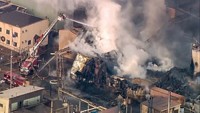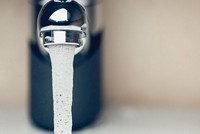Advertisement
Grab your lab coat. Let's get started
Welcome!
Welcome!
Create an account below to get 6 C&EN articles per month, receive newsletters and more - all free.
It seems this is your first time logging in online. Please enter the following information to continue.
As an ACS member you automatically get access to this site. All we need is few more details to create your reading experience.
Not you? Sign in with a different account.
Not you? Sign in with a different account.
ERROR 1
ERROR 1
ERROR 2
ERROR 2
ERROR 2
ERROR 2
ERROR 2
Password and Confirm password must match.
If you have an ACS member number, please enter it here so we can link this account to your membership. (optional)
ERROR 2
ACS values your privacy. By submitting your information, you are gaining access to C&EN and subscribing to our weekly newsletter. We use the information you provide to make your reading experience better, and we will never sell your data to third party members.
Business
Inherently Safer Water Purification
Use of on-site bleach generation grows as an alternative to shipping chlorine
by Marc S. Reisch
February 9, 2009
| A version of this story appeared in
Volume 87, Issue 6
WATER CHLORINATION is a pillar of modern water treatment because it prevents the transmission of waterborne diseases. But chlorine is a hazardous gas that can be lethal if mishandled.
Using sodium hypochlorite bleach, which is made from chlorine, is one way to minimize the dangers of shipping chlorine while still meeting water disinfection standards. That benefit is proving to have market value: Companies such as Olin and JCI Jones Chemical are expanding their ability to distribute high-concentration beach. Other firms such as K2 Pure Solutions and Bleach Tech have built industrial-sized plants to produce bleach by electrolytically splitting sodium chloride into chlorine and sodium hydroxide and then immediately recombining them into bleach (C&EN, Dec. 10, 2007, page 20).
But makers of small on-site bleach generators claim they can go one step safer. Firms such as Severn Trent Services, ChlorKing, and Miox say they can equip many of the more than 50,000 U.S. water service utilities with units that generate an easy-to-handle dilute bleach solution with nothing more than salt, water, and a power source.
Such on-site units, ranging in size from handheld units to 4- by 4-foot or larger skid-mounted units and costing anywhere from $3,000 to a few hundred thousand dollars, minimize safety concerns by obviating the need to transport either chlorine or bleach. And because they generate a low-concentration bleach solution, typically 1% or less, environmental officials often consider the product nonhazardous.
On-site bleach generators were first developed in the 1970s, says Ali Giti, director of sales for Severn Trent Services, which makes and installs skid-mounted sodium hypochlorite-generating units mostly for municipal water treatment. The firm's ClorTec brand generators have been around since 1989, Giti says, but they really caught on after the terrorist attacks of Sept. 11, 2001. He says Severn has installed about 3,500 on-site units throughout North America.

Chlorine is typically made at large chlor-alkali plants via electrolysis of a salt solution; the process also yields sodium hydroxide. Shipped via rail in tank cars, the chlorine gas is sold to large industrial users and municipal water treatment plants. The industrial users include bleach companies. These firms sell a 5 to 6% solution of household bleach in plastic jugs to consumers and a 12 to 15% solution by the truckload to smaller water treatment plants and industrial users such as papermakers and laundries.
But manufacturing bleach poses hazards to large population centers, claims the Center for American Progress (CAP), a left-leaning think tank. In a report issued in November, "Chemical Security 101," CAP says 30 bleach makers are among the 101 highest hazard facilities in the U.S. because they receive rail shipments of chlorine from chemical producers such as Olin and Occidental Chemical. Converting the 30 bleach makers to producing on-site, as K2 and Bleach Tech do, "would eliminate their toxic gas danger to some 50 million people, plus more along rail delivery routes," according to the report.
Another 15 of the 101 highest hazard facilities are water utilities. Eleven of them use chlorine gas. Although the report acknowledges that about 100 large utilities stopped using chlorine between 1999 and 2006, it points out that "approximately 1,650 drinking water plants and 1,000 wastewater plants still report [using] extremely hazardous substances, primarily chlorine gas" under the Environmental Protection Agency's Risk Management Plan program. Severn Trent and its competitors see these facilities as a large potential market for their on-site bleach generation equipment.
According to Rodney Jackson, superintendent for the water treatment plant in Valdosta, Ga., his facility used to truck in cylinders of chlorine to disinfect water. It has since installed a small on-site unit that generates a 0.8% solution of sodium hypochlorite. There was always some concern about accidental releases in handling the chlorine cylinders, Jackson says. But ever since the city installed the bleach generator, he adds, his risk management headaches have subsided considerably.
Many municipalities treat the output of such low-concentration-bleach generators as nonhazardous, Severn Trent's Giti says. Also, the generators have a distinct advantage in southwestern and southeastern states because stored bleach degrades rapidly under warm conditions, he says. Generating only as much as they need for a few days at a time allows water treatment plant operators to have bleach available at a consistent strength, with a buffer in case of power interruption or maintenance downtime.
POWER COSTS are a concern, too. In most of the warmer states, electricity is often cheap enough that customers can generate bleach at a cost nearly equivalent to buying chlorine, Giti says. But in the Northeast, electric rates are generally higher, and shipped-in chlorine or bleach is less expensive. "Our major competitors are sellers of high-strength sodium hypochlorite," he says.
Carlos Perea, chief executive officer of Miox, which produces low-strength-bleach generators, points out other advantages to on-site generation, particularly in the Southeast. Because perchlorate and other undesirable by-products are produced when sodium hypochlorite degrades in warm climates, a fresh solution is preferable. Also, hurricanes and other natural disasters can delay deliveries of chlorine or bleach. The on-site units can run on emergency generators as long as a stock of salt is on hand.
Miox, a venture-capital-backed firm based in Albuquerque, N.M., supplies two types of on-site generators. One type, similar to that from Severn Trent, generates a 0.8% bleach solution. The other produces a mixed oxidant solution of 0.4% sodium hypochlorite and other oxidants such as ozone and hydrogen peroxide, depending on the configuration. Perea says his firm sells generators ranging from battery-powered handheld units initially developed for the U.S. military to treat a half liter of water to 8- by 3-foot units that can treat 150 million gal per day.
Another firm, ChlorKing, specializes in supplying wall-mounted bleach generators to spas, water parks, hotels, and municipal pools. Capable of generating the equivalent of 1.25 to 25 lb of chlorine per day, the units generate sodium hypochlorite from salt that is added to the pool water and circulated through an electrolytic cell, says Steven J. Pearce, vice president of the Georgia-based firm.
As a measure of how far on-site bleach generation has come, Equipment & Systems Engineering, a Miami-based bleach equipment maker, sells its Aquachlor Kit, a 150-lb ruggedized container about the size of a trash can. Packed with salt, an electrolytic unit, and solar power cells, it can be air dropped into disaster areas. Within four hours, the kit can produce enough low-strength bleach to treat more than 20,000L of water, company owner José Masís says. The kits were used last September to provide clean water to victims of Hurricane Ike in the Caribbean.
Although chlorination is still critical to ensuring water purity, chlorine itself need not always be the agent of disinfection. And even though high-strength bleach is increasingly available, the option to generate low-strength bleach on-site is one that utilities are turning to more and more.






Join the conversation
Contact the reporter
Submit a Letter to the Editor for publication
Engage with us on Twitter